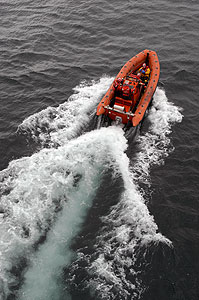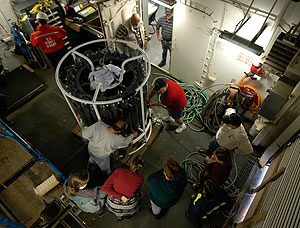|
|
 |
Daily Update
Calendar
Dispatch 03 - September 3, 2004
By C. A. Linder
Weather conditions: Mostly cloudy skies, intermittent rain,
10 kt winds, calm seas, air temperature 54° F
Back to School
Gray skies, gray waves. Today we continued
our steady progress northward through the Bering Sea (see our latest
position on this map). Light rain fell
intermittently throughout the day, and most of us spent the day inside.
Despite the reputation this area has for terrible storms, we have
enjoyed relatively light winds and calm seas. This evening the island
of Nunivak was visible to the east. University of Alaska Fairbanks
researchers Seth Danielson and Tom Weingartner have spent years studying
the oceanography of the Bering Sea. I caught up with Seth and he told
me this story about his research and Nunivak:
"In September 2002, Tom and I sent fifteen buoys to Larson King of Mekoryuk, Nunivak Island. Using his boat, Larson and his crew deployed the buoys for us just offshore of the island. The drifters recorded their position and sea surface temperature and relayed that information to a satellite, which was then sent to us in Fairbanks. Our collaboration with the Mekoryuk community members worked out well for everyone - we all learned more about the nearshore circulation and we developed partnerships with the local community members, partnerships that we hope to build upon in the future. Two scientific papers are currently being written that incorporate results of this drifter dataset."
To see the drifter data and learn more about circulation in the Bering Sea, visit Seth and Tom's website.
 |
 |
| The rescue team, led by Ensign Cooley (in yellow), races off to retrieve the practice dummy. |
Click
to enlarge
|
The Healy crewmembers took advantage
of our transit time to install a new engine
in one of their small boats. The engine got a thorough testing during
a man overboard drill. Drills are used to keep everyone's responses
sharp. The water here is very cold, and every minute is precious in
a rescue attempt. At the start of the drill, a dummy was thrown over
the side. Within moments, the alarm was blaring and people were rushing
to their assigned stations. The ship was immediately thrown into reverse
and it felt like an earthquake was shaking the ship as she shuddered
to a stop. A team of rescuers, led by Ensign Cooley, boarded the small
boat and whisked off to retrieve the
dummy. In a matter of minutes they had returned to the Healy and safely
delivered their charge--mission accomplished.
The science party is also making good use of the transit time to study
the procedures we will use when we get to our science stations in
the Arctic. Today Dan Schuller and Erik Quiroz held a "water
sample class" for the CTD watchstanders. The CTD is one of our
most basic instruments for finding out the temperature, saltiness,
and nutrient levels in the water. Large bottles, called Niskin bottles,
trap water from different depths in the ocean during a "cast." Dan
and Erik showed everyone how to extract water from the Niskin bottles
using the proper procedures.
 |
 |
| Erik Quiroz (in red) explains the finer points of taking water samples from the Niskin bottles (long gray bottles on the CTD rosette at left). |
Click to enlarge
|
As Chief Scientist Bob Pickart explained to me "proper procedure is critical to our science. A contaminated sample can actually give us a misleading impression of the environment."
Tomorrow the science party will get to put their skills to the test.
Three test CTD casts are scheduled. In addition, Jeremy Mathis will
be flying off to the mouth of the Yukon River to measure the properties
of the water there. Dave Kadko spent some time today devising a very
interesting device to filter the water. More tomorrow!

|
Traducido al Espaņol por Celia |
Vuelta al cole
El cielo y el mar estan grises. Hoy, aun continuamos rumbo al mar
de Bering (se puede ver nuestra posicion en el mapa). Ayer estuvo
lloviznando intermitentemente a lo largo del dia, y la mayoria de
nosotros estuvimos dentro del barco. Esta zona tiene fama de terribles
tormentas, sin embargo nosotros hemos disfrutado de un viento suave
y del mar en calma. Esta noche pudimos ver la isla de Nunivak al este.
Los investigadores de la Universidad de Alaska Fairbank, Seth Danielson
y Tom Weingartner llevan varios anos realizando estudios oceanograficos
en el mar de Bering. Seth me ha contado una historia sobre su investigacion
y Nunivak:
"En septiembre de 2002, Tom y yo enviamos quince boyas a Larson King
of Mekoryuk, Nunivak Island. Usando su barco, Larson y su tripulacion
desplegaron las boyas alrededor de la isla. Los correntimetros grababan
su posicion y la temperatura superficial del agua y enviaban esta
informacion, via satelite, a Fairbanks. Nuestra colaboracion con los
miembros de la comunidad de Mekoryuk fue buena para todos- todos nosotros
aprendimos mas acerca de la circulacion interna de la isla y establecimos
lazos de union con los miembros de la comunidad local, los cuales
esperamos mantener en el futuro. De esto han surgido dos publicaciones
cientificas que incluyen los datos obtenidos con los correntimetros."
Para ver los datos de los correntimetros y aprender mas sobre la circulacion
del mar de Bering, se puede visitar la pagina web de Seth y Tom.
Los miembros de la tripulacion del Healy aprovecharon nuestro
trayecto para instalar un nuevo motor
en uno de sus pequenos botes, que fue sometido a un test durante un
simulacro de hombre al agua. Los simulacros se utilizan par mantener
a la tripulacion preparada en caso de emergencia. El agua aqui esta
muy fria, y los rescates hay que realizarlos en el menor tiempo posible.
Al comienzo del simulacro se lanzo un muneco por la borda. Mientras
la alarma sonaba la tripulacion se dirigia a sus puestos. El barco
se detuvo inmediatamente y parecia como si hubiera un terremoto dentro,
debido a los motores. Un grupo de rescate, dirigido por Ensign Cooley,
tripularon el bote pequeno y se dirigieron a recuperar el muneco.
En cuestion de minutos volvieron al Healy --mision cumplida.
El comite cientifico esta aprovechando el trayecto para probar los
equipos y el metodo de trabajo que se utilizara en el Artico. Hoy,
Dan Schuller y Erik Quiroz obtuvieron unas muestras de agua del CTD.
El CTD es uno de nuestros instrumentos mas basicos para medir temperatura,
salinidad y nivel de nutrientes en el agua. Se lanza junto a un roseta
de botellas, llamadas botellas Niskin, que recogen el agua a la profundidad
deseada. Dan y Erik mostraron a todos como extraer agua de las botellas
Niskin usando sus propios procedimientos.
El jefe de campana Bob Pickart me explico que "el metodo de trabajo
es muy importante ya que una muestra contaminada puede aportar informacion
erronea de lo que estamos estudiando."
Manana el comite cientifico pondra sus equipos a prueba. Esta programado
lanzar tres CTD. Ademas, Jeremy Mathis volara hasta la desembocadura
del rio Yukon para medir las propiedades del agua alli. Dave Kadko
trabajara en un interesante metodo para filtrar el agua. Mas manana!
 Previous
Dispatch
Next Dispatch Previous
Dispatch
Next Dispatch

Back to Calendar
|
|




